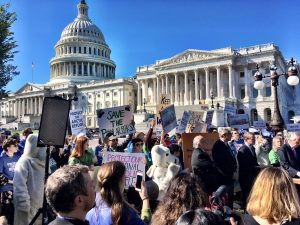
For decades, environmental groups warned that Big Oil would plunder the coastal plain of the Arctic National Wildlife Refuge if Congress opened the area to drilling. On Thursday, the U.S. Senate will hold a hearing on whether to allow drilling in the refuge as part of the Republican tax plan, and now the environmental argument has shifted. A report commissioned by the Alaska Wilderness League claims drilling advocates are exaggerating industry’s interest in the refuge.
The budget plan Congress passed last month calls on the Senate Energy Committee to come up with $1 billion in federal revenues over the next decade. Sen. Lisa Murkowski chairs that committee and says allowing oil lease sales in the refuge are the best way to fulfill the directive.
But David Murphy of St. Lawrence University in New York contends that’s unlikely.
“The idea that we could raise $1 billion from bonus bids seems to be outlandishly high,” Murphy said.
Murphy, an assistant professor of environmental studies, says oil companies would have to lease every single one of the roughly 1.5 million acres along the coast of the refuge, the so-called “1002 area,” for more than $1,300 dollars.
“The average over the past two decades for the entire North Slope is $34” an acre, Murphy said. And his estimates assume the revenue would be split 50-50 between the state and the feds, as prior bills have proposed, rather than the 90-10 split promised to Alaska in the statehood compact.
Ultimately, it will be up to the Congressional Budget Office to calculate whether Murkowski’s ANWR legislation would hit the $1 billion mark the budget calls for. The more important sum might be 51. That’s the number of votes it takes to pass a budget bill of this type under Senate rules.
Democrats tried to remove ANWR from the budget last month but got only 48 votes. It’s not obvious how that math would be any different if the Senate votes on it again as part of a tax package.
“Well, the first strategy is defeat the tax package,” Sen. Tom Udall, D-N.M., said. A drilling foe, Udall says Democrats plan a multi-pronged approach. “We think we have the potential with such a close vote to change some minds.”
One senator to watch is Susan Collins, R-Maine. She was the only Republican to side with Democrats in last month’s ANWR vote. Republican leaders are said to be debating changes to their tax plan to pick up moderates like her. Collins has been a consistent vote against drilling in the refuge throughout her career, but she and Murkowski are allies on issues like health care and funding for Planned Parenthood, and Collins said she was keeping an open mind ahead of the Energy Committee’s hearing on ANWR.
“Right now, I haven’t heard anything that has caused me to change my position, but I never say never because there may be new information,” Collins said Tuesday, in a Senate hallway.
Murkowski has Alaskans lined up to discuss the benefits of drilling in ANWR at the hearing. They include every statewide elected officeholder – herself, her Senate colleague and Congressman Don Young, as well as the governor and the lieutenant governor. Other witnesses include tribal administrator Matthew Rexford of Kaktovik; Aaron Schutt, CEO of Doyon Ltd., the Native regional corporation for the Interior; and Arctic Slope Regional Corp. Vice President Richard Glenn.
Other Alaskans will testify against drilling. They include Lois Epstein of The Wilderness Society and Gwich’in tribal member Samuel Alexander.
Liz Ruskin is the Washington, D.C., correspondent at Alaska Public Media. Reach her at lruskin@alaskapublic.org. Read more about Liz here.





